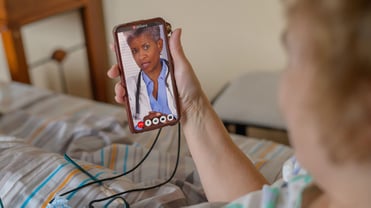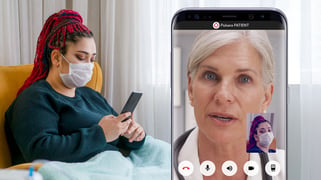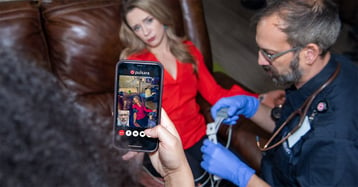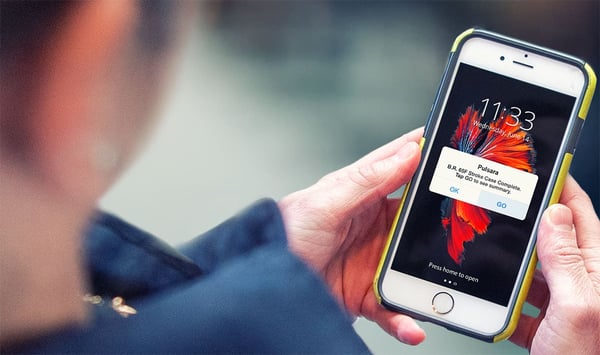Does Your Team Feel Unseen? Close the Leadership Disconnect with 2-Way Communication
Editor's Note: In July 2025, EMS1 and Fitch & Associates released their annual EMS trend survey, What Paramedics Want, proudly sponsored by Pulsara....
4 min read
 Team Pulsara
:
Dec 11, 2020
Team Pulsara
:
Dec 11, 2020

EDITOR'S NOTE: This article originally appeared on EMS1.com. Special thanks to our guest author, Sarah Calams of EMS1 BrandFocus.
__
With today’s advanced technology, anyone can use their smartphone, tablet, or computer to connect via real-time video to talk with anyone around the world.
Yet, in the healthcare system, video streaming has remained static, convoluted, and complicated.
Instead of understanding the benefits of providers carrying around a telemedicine device in their back pocket, many agencies and hospital systems remain reluctant to make a technological change. However, this reluctance has become less prevalent due to the COVID-19 pandemic.
Hospitals and EMS agencies can no longer ignore the rise of technology. More importantly, many have realized not only is video streaming more convenient, it also minimizes potential exposure to EMS providers, hospital staff members, and their patients.
Telehealth applications, such as live video streaming, benefit the patient by enabling doctor-directed care sooner for improved treatment and outcomes.
The potential efficiency, opportunity – and, more specifically, the technology – have not been fully adopted, whether for out-of-hospital or in-hospital care. But with the COVID-19 pandemic changing the ways we interact, EMS agencies and healthcare systems have slowly but surely started improving the patient experience by bringing healthcare to a patient’s living room.
“It’s more about expanding clinics and medicine,” said Kris Kaull, chief marketing officer at Pulsara, a healthcare communication and telehealth platform, and co-founder of EMS1.com.
 For example, if a patient is experiencing COVID-19 symptoms, they don’t have to get in their car, drive to their doctor’s office, sit in a waiting room and potentially infect other non-COVID patients, or come in contact with their primary physician.
For example, if a patient is experiencing COVID-19 symptoms, they don’t have to get in their car, drive to their doctor’s office, sit in a waiting room and potentially infect other non-COVID patients, or come in contact with their primary physician.
Instead, with live video, a patient can skip the doctor visit – or ambulance transport – and receive medical advice at home.
“There’s this ability to reduce exposure and preserve PPE,” Kaull said. “I don’t have to assess you in person, so that means I don’t have to use a mask, gloves or gowns.”
Live video streaming also better informs treatment decisions, Kaull says.
“Our typical practice has been, if you have a bellyache, major car crash or a hangnail, I’m going to transport you,” he said. “I might assess and treat that assessment differently, based on the injury or illness, but I’m still going to put you in the ambulance and take you to the hospital.”
Now, thanks to advances in technology, this typical transport method for an EMS agency doesn’t always have to be the answer, Kaull says.
“Now, we say, ‘Oh, wait. Here’s what we’re going to do – let’s get some consultations and make sure we’re doing the right thing at the time for that patient,’” he said.
 Pulsara is taking it a step further: Earlier this year, the company expanded its video-enabled platform to not only allow patients to get medical advice at home, but also to give physicians the ability and opportunity to follow up – without the risk of exposure.
Pulsara is taking it a step further: Earlier this year, the company expanded its video-enabled platform to not only allow patients to get medical advice at home, but also to give physicians the ability and opportunity to follow up – without the risk of exposure.
Through Pulsara PATIENT, physicians can send a text to the patient, instructing them to download the app and inviting them to a secure virtual appointment. This allows the patient and their provider to connect and communicate via live video.
This solution not only simplifies and accelerates care, but also minimizes exposure and allows providers to preserve PPE, which is already scarce due to nationwide shortages.
With the Pulsara app, all members of the care team can connect via the HIPAA-compliant, real-time video streaming platform, regardless of a provider’s location or type of organization.
If an EMS provider concludes that their patient needs more specialized care, they can use the app to give the hospital advance notice about their arrival. This allows healthcare providers the opportunity to better prepare for incoming patients, especially when specialized care is needed.
 EMS agencies, such as the Colorado Springs Fire Department, are using the app to give the hospital a heads-up about the patient’s signs and symptoms and what their stroke scale was on scene – all before they arrive at the emergency department. Added guidance en route also helps medics provide the most appropriate care and provide real-time reporting to hospital providers.
EMS agencies, such as the Colorado Springs Fire Department, are using the app to give the hospital a heads-up about the patient’s signs and symptoms and what their stroke scale was on scene – all before they arrive at the emergency department. Added guidance en route also helps medics provide the most appropriate care and provide real-time reporting to hospital providers.
“If the hospital knows what’s going on early, and they have the access to the right information, then we can pre-alert and notify them with all the COVID-19 information in a simple tab,” Kaull said. “They can get the patient pre-registered and be prepared for them.”
Another benefit of using the Pulsara app, he says, is the benefit of real-time feedback.
In EMS, it’s normal for a provider to transport a patient to the hospital and never hear about the patient’s outcome. Once a patient enters the hospital’s care, their treatment is documented, and eventually their case is closed.
But with Pulsara, everyone on the care team receives instant feedback – including EMS.
“It isn’t siloed, where, ‘Oh, I took the patient to the hospital, dropped them off and will never hear anything else,’” Kaull said. “I’m starting the case at the bedside, and then I’m going to be a part of that entire healthcare continuum, and I’ll be able to see the outcome.”
This mentality shift, Kaull says, strengthens relationships at the provider and patient level and directly benefits onboarding education and training with EMS providers and physicians. This enhanced communication also helps close the loop so EMS providers are better able to assess and adjust their response.
“There is an absolute responsibility to do what’s in the best interest of the patient,” Kaull said. “Pulsara allows you to do telehealth, and it’s secure and HIPAA-compliant. It’s all about doing the right thing.”
About the Author
Sarah Calams previously served as associate editor of EMS1 and Lexipol. In addition to her regular editing duties, Sarah delved deep into the people and issues that make up the EMS industry to bring insights and lessons learned to EMS providers everywhere. Sarah graduated with a bachelor's degree in news/editorial journalism at the University of North Texas in Denton, Texas.
To learn about how EMS leaders are using cutting edge technology to help treat patients in place during the COVID-19 pandemic, check out 911-Initiated Telemedicine: How Clinical Leaders are Using Mobile Tech.

Editor's Note: In July 2025, EMS1 and Fitch & Associates released their annual EMS trend survey, What Paramedics Want, proudly sponsored by Pulsara....
![[PRESS RELEASE] Published Research Finds Up to 31% Faster STEMI Treatment Times in Rural Hospital Setting with Pulsara](https://www.pulsara.com/hubfs/_1_website-page-blog-assets/pulsara-hosp-teams-assign-cardio-stemi-rn-1200x701.jpg)
Published research shows how using Pulsara, alongside standardized field activation and a focus on stakeholder relationships, improves STEMI care and...

Editor's Note: In July 2025, EMS1 and Fitch & Associates released their annual EMS trend survey, What Paramedics Want, proudly sponsored by Pulsara....